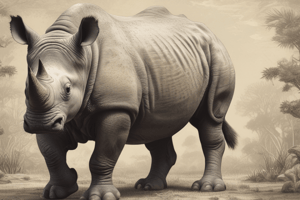Podcast
Questions and Answers
Which of the following is not a threat to rhinoceros populations?
Which of the following is not a threat to rhinoceros populations?
- Urban development
- Human-wildlife conflict
- Poaching for their horns
- Habitat restoration efforts (correct)
Which protection effort helps mitigate human-wildlife conflict?
Which protection effort helps mitigate human-wildlife conflict?
- Legal protections under CITES
- Anti-poaching patrols
- Habitat loss due to agriculture
- Community engagement and education programs (correct)
What is a primary nutritional preference of white rhinoceroses?
What is a primary nutritional preference of white rhinoceroses?
- Grass (correct)
- Bark of trees
- Leaves and shrubs
- Fruit
Which of the following habitats is least likely to be preferred by rhinoceroses?
Which of the following habitats is least likely to be preferred by rhinoceroses?
Which term best describes the riskiest classification for the Javan rhinoceros according to the IUCN Red List?
Which term best describes the riskiest classification for the Javan rhinoceros according to the IUCN Red List?
Which rhinoceros species is known for its armor-like skin and primarily inhabits India and Nepal?
Which rhinoceros species is known for its armor-like skin and primarily inhabits India and Nepal?
Which statement about the Northern white rhinoceros is correct?
Which statement about the Northern white rhinoceros is correct?
What characteristic differentiates the black rhinoceros from the white rhinoceros?
What characteristic differentiates the black rhinoceros from the white rhinoceros?
What behavior is typical of most rhinoceros species?
What behavior is typical of most rhinoceros species?
Which species of rhinoceros is currently considered the smallest and most endangered?
Which species of rhinoceros is currently considered the smallest and most endangered?
Flashcards are hidden until you start studying
Study Notes
Threats and Protection Efforts
- Threats:
- Poaching for horns (valued in traditional medicine and as status symbols).
- Habitat loss due to agriculture, urban development, and deforestation.
- Human-wildlife conflict leading to retaliatory killings.
- Protection Efforts:
- Anti-poaching patrols and law enforcement in protected areas.
- Habitat restoration and establishment of wildlife corridors.
- Community engagement and education programs to raise awareness.
- Legal protections under national and international laws (CITES).
Behavior and Diet
- Behavior:
- Mostly solitary; some species are more social.
- Territorial, marking areas with urine and dung.
- Generally crepuscular, being active during dawn and dusk.
- Diet:
- Herbivores, primarily feeding on grasses, leaves, and shrubs.
- Different species have specific dietary preferences (e.g., white rhinos prefer grass, while black rhinos favor bushes and trees).
Conservation Status
- IUCN Red List:
- Various species listed as Critically Endangered, Endangered, or Vulnerable.
- Examples:
- Javan rhinoceros: Critically Endangered.
- Black rhinoceros: Critically Endangered.
- White rhinoceros: Near Threatened (Southern white rhino more stable, while Northern white rhino is functionally extinct).
Habitat and Distribution
- Habitat:
- Prefer savannas, grasslands, and tropical forests.
- Require water sources for drinking and mud wallowing.
- Distribution:
- Native to Africa and parts of South Asia.
- Major populations in South Africa, Namibia, Zimbabwe, and India (for the Indian rhinoceros).
Species Identification
- Major Species:
- White Rhinoceros:
- Largest species, split-lipped for grazing.
- Two subspecies: Southern (more common) and Northern (critically endangered).
- Black Rhinoceros:
- Smaller, hooked lip for browsing.
- More aggressive and solitary.
- Indian Rhinoceros:
- One-horned with thick, armor-like skin.
- Found primarily in India and Nepal.
- Javan Rhinoceros:
- Also one-horned; critically endangered with very few individuals remaining.
- Restricted to Ujung Kulon National Park in Indonesia.
- Sumatran Rhinoceros:
- Smallest and most endangered; hairy skin.
- Distributed in Indonesia, primarily on the islands of Sumatra and Borneo.
- White Rhinoceros:
Threats and Protection Efforts
- Poaching driven by demand for horns in traditional medicine and as status symbols.
- Habitat destruction caused by agriculture, urban expansion, and deforestation.
- Human-wildlife conflict results in retaliatory killings of rhinos.
- Anti-poaching initiatives include patrols and strict law enforcement within protected areas.
- Habitat restoration efforts involve establishing wildlife corridors to facilitate movement.
- Community programs aim to educate locals and raise awareness about rhino conservation.
- Legal protections are enforced under national laws and international treaties like CITES.
Behavior and Diet
- Many rhino species exhibit solitary behavior; some species display social tendencies.
- Rhinos are territorial, marking their domains with urine and dung.
- They are primarily crepuscular, being most active during dawn and dusk.
- As herbivores, rhinos primarily consume grasses, leaves, and shrubs.
- Dietary preferences vary by species: white rhinos prefer grass, while black rhinos favor browsing on bushes and trees.
Conservation Status
- Various rhino species are categorized as Critically Endangered, Endangered, or Vulnerable on the IUCN Red List.
- The Javan rhinoceros is listed as Critically Endangered with an extremely low population.
- Black rhinoceroses are also critically endangered, facing severe survival threats.
- Southern white rhinoceros is listed as Near Threatened, while the Northern white is functionally extinct.
Habitat and Distribution
- Rhinos thrive in savannas, grasslands, and tropical forests, requiring accessible water sources.
- Major populations are concentrated in South Africa, Namibia, Zimbabwe, and India (notably for the Indian rhinoceros).
Species Identification
- White Rhinoceros:
- Largest species with a split lip adapted for grazing; includes two subspecies: Southern (more stable) and Northern (critically endangered).
- Black Rhinoceros:
- Smaller with a hooked lip for browsing; generally more aggressive and prefers solitude.
- Indian Rhinoceros:
- Recognizable by its single horn and thick, armor-like skin; primarily found in India and Nepal.
- Javan Rhinoceros:
- One-horned, critically endangered species with very few individuals, primarily located in Ujung Kulon National Park, Indonesia.
- Sumatran Rhinoceros:
- The smallest species, known for its hairy skin; primarily inhabits Sumatra and Borneo Islands in Indonesia.
Studying That Suits You
Use AI to generate personalized quizzes and flashcards to suit your learning preferences.




